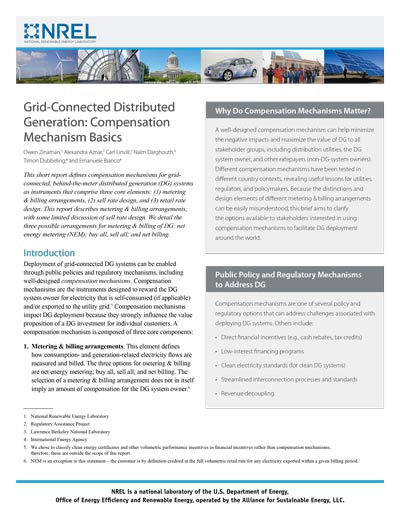- Energy Home
- How We Work
- Programs & Initiatives
- EmPOWERing Women and Girls
- Competitive Energy Procurement
- Toolkits
- Monitoring & Evaluation
- Resources
- Stories
Speeches Shim
This brief describes metering and billing arrangements, with some limited discussion of sell rate design for grid-connected, behind-the-meter distributed generation systems. Three possible arrangements for metering and billing are discussed: net energy metering; buy all, sell all; and net billing.
Deployment of grid-connected distributed generation (DG) systems can be enabled through public policies and regulatory mechanisms, including well-designed compensation mechanisms. Compensation mechanisms are the instruments designed to reward the DG system owner for electricity that is self-consumed and/or exported to the utility grid. Compensation mechanisms impact DG deployment because they strongly influence the value proposition of a DG investment for individual customers.
A compensation mechanism is composed of three core components:
- Metering & billing arrangements. This element defines how consumption- and generation-related electricity flows are measured and billed. The three options for metering & billing are net energy metering; buy all, sell all; and net billing. The selection of a metering & billing arrangement does not in itself imply an amount of compensation for the DG system owner.
- Sell rate design. This element defines the exact level of compensation a DG system owner receives for electricity exported from the DG system to the utility grid. The sell rate applies to distinct quantities, depending on the metering & billing arrangement selected (this will be described in more detail below). Sell rates can be static, remaining fixed over the length of an interconnection contract. They can also be more dynamic in nature, changing with time or by location with various degrees of granularity.
- Retail rate design. This component defines the retail tariff structure and exact purchase rates the DG system owner must pay for electricity from the grid, and thus which costs the DG system owner can avoid if they self-consume the electricity produced by their DG system.
A well-designed compensation mechanism can help minimize the negative impacts and maximize the value of DG to all stakeholder groups, including distribution utilities, the DG system owner, and other ratepayers (non-DG-system owners). Different compensation mechanisms have been tested in different country contexts, revealing useful lessons for utilities, regulators, and policymakers. Because the distinctions and design elements of different metering & billing arrangements can be easily misunderstood, this brief aims to clarify the options available to stakeholders interested in using compensation mechanisms to facilitate DG deployment around the world.



Comment
Make a general inquiry or suggest an improvement.